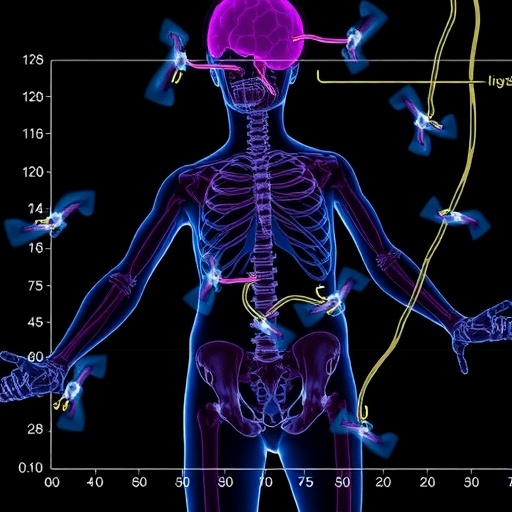
In the intricate dance of cellular development, metabolic pathways are far from mere background players; they are vital orchestrators that remodel and redefine the very identity of a cell. Recent advances in stem cell biology and metabolic research have raised an intriguing question: how do intracellular metabolic shifts during developmental transitions influence a cell’s reliance on nutrients from its environment? A groundbreaking study by Jackson et al., soon to be published in Nature Metabolism, uncovers a fascinating aspect of embryonic stem (ES) cell metabolism that challenges conventional wisdom about nutrient dependency in cellular states. Their research reveals that naive ES cells possess a unique metabolic signature characterized by an elevated requirement for exogenously supplied pyruvate—a small but pivotal metabolite previously overshadowed by glucose and glutamine in cellular metabolism discourse.
Embryonic stem cells represent one of the most plastic and versatile cell types, capable of self-renewal while retaining the potential to differentiate into diverse lineages. Within this population, cells continuously toggle through metabolic states that correspond with their developmental potential. The “naive” ground state of pluripotency, which reflects an early embryonic identity, has now been shown to harbor a distinct metabolic dependency not fully appreciated until this study: a pronounced reliance on external pyruvate uptake. Despite the abundant presence of canonical pyruvate precursors such as glucose and lactate within the cellular milieu, these naive ES cells preferentially consume pyruvate transported directly from their environment, fundamentally altering the paradigm of intracellular metabolic flux.
At the heart of this discovery lies the identification of the monocarboxylate transporter 1 (MCT1) as a key facilitator of pyruvate import. Historically recognized for its role in lactate transport, MCT1 emerges here as an essential gatekeeper for exogenous pyruvate, mediating its influx into naive ES cells. The elevated expression and functional activity of MCT1 in these cells contrasts sharply with the more committed progenitor populations that seem less dependent on exogenous pyruvate. This specificity suggests a tightly regulated adaptation possibly linked with the metabolic needs of sustaining pluripotency and early developmental programming.
Metabolically, what drives this dependence on extracellular pyruvate? Jackson and colleagues elucidate that naive ES cells exhibit heightened mitochondrial pyruvate oxidation, shunting a significant fraction of imported pyruvate into the tricarboxylic acid (TCA) cycle. This elevated mitochondrial pyruvate consumption is not simply a function of energetic demand but is intricately tied to the cellular redox balance, particularly the regeneration of cytosolic NAD⁺. Strikingly, the increased mitochondrial flux sequesters pyruvate away from cytosolic processes typically responsible for regenerating NAD⁺ through lactate formation, thereby creating a metabolic bottleneck that the cell alleviates by importing pyruvate from outside.
The link between mitochondrial pyruvate metabolism and cytosolic NAD⁺ regeneration reveals a finely tuned intracellular metabolic gradient. By preferentially directing pyruvate towards mitochondrial oxidation, naive ES cells inadvertently limit the cytosolic pool of NAD⁺, an essential coenzyme for glycolytic flux and diverse metabolic reactions. Consequently, these cells rely on exogenous pyruvate not only as a substrate for energy production but also to sustain redox homeostasis—a dual role that underscores the complexity of their metabolic circuitry.
Intriguingly, this study demonstrates that across multiple cell types, artificially increasing mitochondrial pyruvate consumption is sufficient to recapitulate the dependency on extracellular pyruvate. This finding implies that the observed reliance in naive ES cells is not an isolated phenomenon but reflects a broader principle of cellular metabolic adaptation contingent on intracellular pyruvate utilization patterns. Such insights position mitochondrial pyruvate metabolism as a critical determinant of nutrient uptake strategies during development and possibly in pathological states.
The implications for stem cell biology and regenerative medicine are profound. Understanding that naive pluripotent cells are metabolically vulnerable to pyruvate availability offers new avenues for modulating cell fate decisions via metabolic interventions. For instance, manipulating MCT1 activity or modulating mitochondrial pyruvate flux could provide refined control over stem cell maintenance and differentiation protocols, enhancing the efficacy and safety of stem cell-based therapies.
Moreover, the study ventures beyond this metabolic vulnerability to reveal potential strategies for circumventing pyruvate dependency. By restoring cytosolic NAD⁺ regeneration pathways, naive ES cells can tolerate pyruvate depletion under diverse nutrient conditions. This metabolic plasticity underscores the interplay between mitochondrial function and cytosolic redox states, opening exciting prospects for metabolic engineering and therapeutic modulation of stem cell states.
Technically, the research employs a comprehensive suite of methodologies, including metabolite tracing, transporter inhibition assays, and genetic manipulation of metabolic enzymes, to dissect the relationship between pyruvate uptake, mitochondrial function, and NAD⁺ homeostasis. Such integrative approaches unveil the subtleties of metabolic circuitries that classical bulk assays or gene expression analyses alone might overlook.
Additionally, the authors illuminate that the dependency on exogenous pyruvate is not circumvented merely by the presence of other prominent carbon sources such as glucose or lactate. This observation challenges the prevailing notion that pyruvate concentrations within cells derive predominantly from glycolytic activity or lactate interconversion, emphasizing instead the importance of extracellular metabolites in maintaining intracellular equilibrium in specific cellular contexts.
As cellular metabolism is increasingly recognized as a dynamic landscape influencing cell fate, this study highlights the intricate gradients that govern nutrient uptake and metabolic flux. The concept that intracellular metabolic gradients—not just absolute metabolite levels—dictate a cell’s ecological niche and nutrient requirements adds a new layer of complexity to metabolic biology. It suggests that stem cells “sense” and respond to subtle intracellular imbalances by adjusting their membrane transport systems to maintain homeostasis.
Furthermore, this research opens questions regarding the physiological relevance of pyruvate dependency in vivo. Within the embryonic niche, fluctuating pyruvate concentrations or transporter expression patterns might serve as natural cues to regulate stem cell states and embryonic development. These findings therefore not only inform in vitro culture conditions but also deepen our understanding of early developmental metabolism.
Beyond developmental biology, the insights from Jackson et al. could extend to cancer metabolism, where altered mitochondrial pyruvate usage and transporter expression are recurrent themes. Targeting metabolic vulnerabilities analogous to those seen in naive ES cells might contribute to novel therapeutic strategies exploiting tumor metabolic dependencies.
This study also exemplifies the power of combining classical metabolic biochemistry with modern stem cell technology to unravel cellular dependencies with therapeutic and biological significance. The identification of mitochondrial pyruvate metabolism as a metabolic vulnerability paves the way for future research into metabolic checkpoints that regulate pluripotency and differentiation, potentially revolutionizing how cellular metabolism is harnessed in clinical contexts.
In summary, the work by Jackson and colleagues delivers a paradigm-shifting perspective on the metabolic demands of naive embryonic stem cells. It underscores the centrality of intracellular metabolic gradients and transporter-mediated nutrient uptake in maintaining pluripotency and navigating developmental transitions. By spotlighting mitochondrial pyruvate metabolism and exogenous pyruvate reliance, this research adds a crucial piece to the puzzle of cellular metabolism, offering promising new angles for both fundamental biology and translational medicine.
Subject of Research: Embryonic stem cell metabolism; intracellular metabolic gradients; pyruvate uptake and mitochondrial pyruvate consumption; pluripotency metabolic regulation.
Article Title: Intracellular metabolic gradients dictate dependence on exogenous pyruvate.
Article References:
Jackson, B.T., Montero, A.M., Chakraborty, S. et al. Intracellular metabolic gradients dictate dependence on exogenous pyruvate.
Nat Metab (2025). https://doi.org/10.1038/s42255-025-01289-8
Image Credits: AI Generated
Tags: cellular identity and metabolismembryonic stem cell metabolismexogenous nutrient requirements in cellsJackson et al. study on metabolismmetabolic pathways in cellular developmentmetabolic shifts during developmentmetabolic signature of stem cellsnaive embryonic stem cellsNature Metabolism publicationnutrient dependency in cell statespluripotency and metabolic statesreliance on external pyruvate





